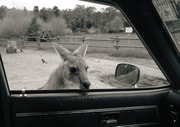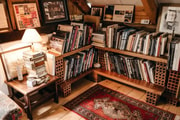
A West Australian woman recently got the shock of her life when cleaning out her bookshelf.
What she discovered lurking amongst her beloved novels was enough to make her 'feel physically sick' - thousands of tiny, translucent insects had turned her precious book collection into their personal buffet.
This was news to one West Australian woman who, when cleaning out her bookshelf recently, discovered that many of her books were 'infested' with what's known as booklice.
Her experience isn't isolated—pest control experts across Australia are fielding calls about these microscopic marauders that are silently wreaking havoc in homes from Perth to Brisbane.
What exactly are book lice?
Book lice, despite their name, aren't actually lice at all. These tiny insects, measuring just 1-2 millimetres in length, are more closely related to termites than the head lice that plague school children.
Booklice are small, pale, and wingless insects, often found in books or damp areas in homes. These bugs are typically less than 1mm long and are usually translucent or light in colour.
The real problem with book lice isn't what they look like, but what they eat. These lice don't consume book material, but rather eat any microscopic spores of mould present in the books. They also tend to feed on starch present in book bindings. This means your treasured first edition novels, family photo albums, and important documents are all on the menu.
The second-hand book connection
If you're one of the growing number of Australians embracing sustainable shopping at op shops and weekend markets, you might unknowingly be bringing these pests home. Book lice are most commonly introduced into a home through the use of secondhand books, but they can also be brought in on clothing, furniture, or other objects.
The problem with pre-loved books is that they've often been stored in less-than-ideal conditions. They can also infest poorly stored items, such as old books and cardboard boxes, especially in humid environments. That vintage cookbook from the church fête or classic novel from the weekend market might come with some unwanted extras.
However, it's not just second-hand shopping that's to blame. Since book lice are so small, they can easily hitch a ride on your clothing or belongings and enter your home without you knowing it. They're also naturally present in the environment and can enter through open windows or doors.
How to spot a book lice invasion
The tricky thing about book lice is that by the time you notice them, you're probably dealing with hundreds or even thousands. Their translucent bodies make them nearly invisible as individuals, and, favouring high humidity, they can lay up to 100 eggs at once.
Signs of book lice to watch out for
- Visual signs: Look for tiny, pale insects crawling on book pages or around bookshelves. Common signs of a booklice infestation include seeing tiny bugs around old books, wallpaper, and damp areas.
- Damage to books: Unlike other pests that chew holes in pages, book lice target the binding. If book pages are falling out when you open them, you might have a problem.
- The sniff test: This is perhaps the most reliable early warning system. If your bookshelf area smells fresh and clean, you're likely in the clear. But if there's a musty, mildew-like odour, it's time to take action.
- Unexpected health effects: Presence of book lice can often lead to skin irritation, especially in individuals with allergies. In fact, allergic reactions on the skin can usually indicate the presence of book lice, similar to irritation caused by dust mites.
Prevention is your best defence
The good news is that booklice infestations are entirely preventable with the right approach. The secret lies in understanding what attracts them: humidity and the mould that thrives in damp conditions.
Effort should be made to reduce the relative humidity in rooms and buildings to less than 50 per cent, drying out infested materials, and eliminating the food source, such as moulds and mildews. In Australia's varied climate, this might mean using air conditioning in humid coastal areas or dehumidifiers in naturally damp regions.
Booklice also thrive in humid environments and require moisture to survive, so using a dehumidifier or air conditioner and opening windows for good airflow is crucial in preventing an infestation. Even something as simple as spacing books apart on shelves can make a significant difference.
Regularly dusting and airing out books can also help prevent infestations. Checking and cleaning storage spaces can help identify potential problems before they escalate into larger infestations.
Before bringing any pre-loved books into your home, give them a thorough inspection. Before getting used books into your home, inspect them for bugs. Though given their tiny size, this isn't foolproof.
Treatment Options: DIY or professional help?
If you discover an infestation, don't panic. The good news is you can manage and control an outbreak without having to call in a professional. However, the approach depends on the severity of the problem.
DIY methods to prevent book lice
Sunlight treatment: Books, papers, or upholstered furniture can be dried in sunlight. This natural method helps eliminate moisture and can kill existing lice.
Freezer method: Infested cereals or stored foods can be discarded or supercooled in a deep freeze at -17 degrees Celsius for seven days.
Improve ventilation: Ventilate and dry areas with a dehumidifier or fan, or open the doors of a damp room.
When should you call professionals?
High numbers of Booklice can indicate problems with dampness and mould in your home, which can lead to structural damage over time and may cause health issues. If you're dealing with a large infestation or suspect underlying moisture problems, professional help might be necessary.
For those with treasured family books, rare editions, or extensive personal libraries, book lice pose a particular threat. The binding damage they cause can be irreversible, turning precious heirlooms into worthless damaged goods.
Your next steps
Book lice can be a sign of other pest problems. They are attracted to mould and fungus, which can indicate a problem with moisture or other pests, such as termites.
For those worried their books could suffer a similar fate, Warren Bailey from ABC Pest Control in Sydney told Yahoo News that while he gets a call 'every so often' for booklice infestations, it's not something that happens as regularly as cockroach or rodent infestations. This suggests that while book lice infestations do occur, they're manageable with proper prevention.
The key to avoiding the book lice nightmare that shocked our West Australian reader is simple: prevention through moisture control and regular maintenance. These tiny pests might be invisible individually, but their impact on your beloved book collection can be devastating.
Start with a simple humidity check—if your bookshelves pass the sniff test and you can keep indoor humidity below 50%, you're already ahead of the game. Regular dusting, proper spacing, and good ventilation will take care of the rest.
Have you discovered book lice in your home, or do you have tips for keeping your book collection pest-free? Share your experiences in the comments below—your advice could save someone else's treasured library.








